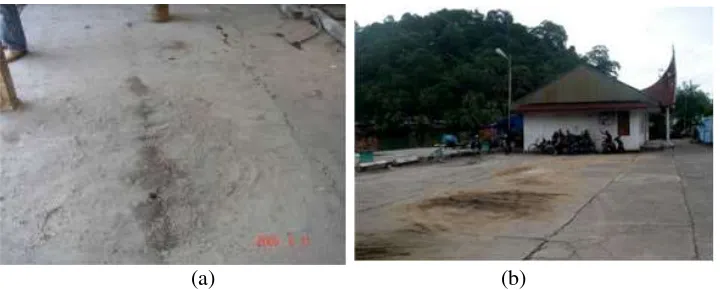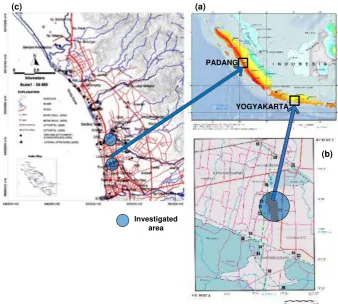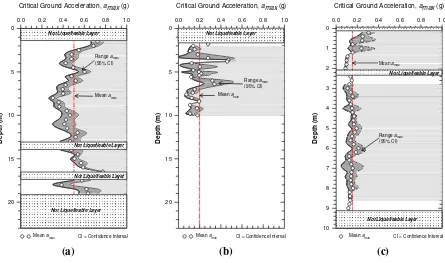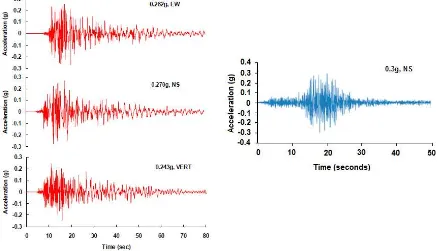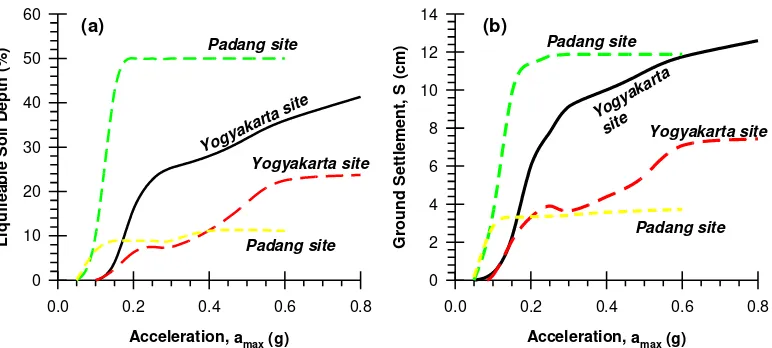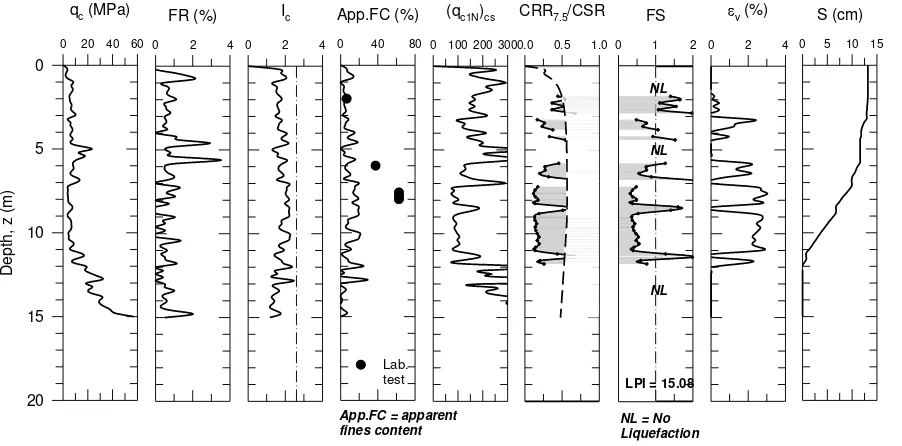1
Research on Earthquake Induced Liquefaction in
Padang City and Yogyakarta Areas
Agus Setyo Muntohar
Department of Civil Engineering, Universitas Muhammadiyah Yogyakarta, D.I.Yogyakarta. Email: [email protected]
ABSTRACT: Awareness and research on earthquake resistant building design has been intensively carried out after the fatal earthquakes in Indonesia in recent decades. However, less attention has been given to the phenomena of liquefaction due to lack of ground motion information and records at the hazard areas. In this paper, seismic ground response after two deadly earthquakes shocked Java and Sumatera (Indonesia) in 2006 and 2009 was evaluated based on the CPT data. Based on back-calculation results, the possible ground accelerations were expected to be about 0.48g and 0.14g in those liquefied areas at Yogyakarta (Southern Java) and Padang (West Sumatera) respectively. Those accelerations are likely to make 50% of the thickness of sand layer liquefied and induced about 1% ground settlement.
Keywords : liquefaction, peak ground acceleration, silty sand, CPT
ABSTRAK: Kesadaran dan penelitian tentang desain bangunan tahan gempa telah gencar dilakukan setelah gempa bumi mematikan di Indonesia dalam beberapa dekade terakhir. Namun, lebih sedikit penelitian yang difokuskan kepada fenomena likuifaksi karena kurangnya informasi gerakan tanah dan catatan di daerah bahaya. Dalam tulisan ini, respon tanah seismik setelah dua gempa bumi yang mematikan terjadi di Jawa dan Sumatera (Indonesia) pada tahun 2006 dan 2009 dievaluasi berdasarkan data CPT. Berdasarkan hasil perhitungan kembali, percepatan tanah mungkin diharapkan sebesar 0.48g dan 0.14g terjadi di daerah ter likuifaksi di Yogyakarta (Jawa Selatan) dan Padang (Sumatera Barat). Percepatan tersebt cenderung membuat 50% dari ketebalan lapisan pasir terlikufaksi dan menyebabkan penurunan tanah sebesar 1%.
Kata kunci : likuifaksi, percepatan tanah puncak, lanau berpasir, CPT
1. INTRODUCTION
In recent decade, notable earthquakes that greater than Mw 6 occur frequently in Indonesia. Several earthquakes caused fatalities, such as the Mw 9.1 earthquake on 26 December 2004 in Aceh, the Mw 6.4 earthquake on 26 May 2006 in Yogyakarta, the Mw 7.7 earthquake on 17 July 2006 in West Java, the Mw 8.5 earthquake on 12 September 2007 in Bengkulu, the Mw 7 earthquake on 2 September 2009 in West Java and the Mw 7.5 earthquake on 30 September 2009 in West Sumatera, and lastly the Mw 6.5 earthquake in Aceh at early July 2013. Some earthquakes followed by large tsunamis, claimed lives of hundreds of thousands people and damaging a half million structures in total.
Agus Setyo Muntohar / Jurnal Geoteknik HATTI IX(1)(2014) 1-9 | ISSN 0853 – 4810
2
(a) (b)
Figure 1. (a). Silty sand liquefaction at UMY campus during the 2006 Yogyakarta earthquake. (b). Silty sand liquefaction at Padang airport during the 2009 West Sumatera earthquake
Figure 2. Grain size distribution of boiling sands at various locations in the earthquake affected region
2. ESTIMATION OF SEISMIC GROUND RESPONSE
3 The factor of safely against liquefaction is defined as:
7.5
L
CRR
FS MSF
CSR
(1)
where CSR is the cyclic stress ratio, CRR is the cyclic resistance ratio of the ground, and MSF is the Magnitude Scaling Factor to convert the CRR7.5 for M = 7.5 to the equivalent CRR for the design earthquake. The recommended MSF is given by Equation (2) based on the NCEER Workshop in 1996 (Youd et al. 2001).
2.56 174
w MSF
M
(2)
Then, acceleration was back-calculated by assuming liquefaction occurs at the observed soil depth which FSL is less than 1. The variation of ground accelerations (amax) with the depth is shown in Figure 5a and 5c for Yogyakarta and Padang sites respectively. In this study, the amax is defined as critical ground acceleration that is the minimum acceleration required to cause liquefaction at a given depth.
PADANG
YOGYAKARTA (a)
(b) (c)
Investigated area
Agus Setyo Muntohar / Jurnal Geoteknik HATTI IX(1)(2014) 1-9 | ISSN 0853 – 4810
Figure 4. Typical CPT data (a). at UMY campus, Yogyakarta. (b). at Agus Salim Sport Complex, Padang
Critical Ground Acceleration, amax (g)
0.0 0.2 0.4 0.6 0.8 1.0
Mean amax CI = Confidence Interval
Range amax
Critical Ground Acceleration, amax (g)
0.0 0.2 0.4 0.6 0.8 1.0
Mean amax CI = Confidence Interval
Range amax
Critical Ground Acceleration, amax (g)
0.0 0.2 0.4 0.6 0.8 1.0
Mean amax CI = Confidence Interval
Range amax
5
The mean critical accelerations at Yogyakarta site range from 0.3g to 0.72g. The largest amax 0.72g is located near ground surface. The values of mean and mode of all critical accelerations are 0.48g and 0.37g respectively. Lee et al. (2006) did analysis of liquefaction by using five CPT dataset of UMY campus and proposed the critical acceleration as shown in Figure 5b. Comparing the profile in Figure 5a and 5b, it shows that the estimated amax of Lee et al. (2006) is likely to be increased by the current study. It implies that an earthquake with amax between 0.11g to 0.48g will generate 50% of sand layer liquefied. Considering the dispersion in PGA and spectral amplification on soft soil deposit Elnashai et al. (2007) estimated the peak ground acceleration (PGA) of Mw 6.4 earthquake of Yogyakarta from YOGI station, which is located about 10 km from the hazard area, that is 0.183g-0.303g and 0.197g-0.336g for horizontal and vertical components, respectively (Figure 6a). The accelerometer of YOGI station was located at the base stiff ground; the maximum horizontal ground motion accelerations are estimated to be 0.49g and 0.47g for Yogyakarta area for horizontal and vertical ground motion respectively (Elnashai et al. (2007). These provide practical available estimates in the absence of more reliable data. Comparing the calculated amax from the CPT evaluation and the estimated value from Elnashai et al. (2007), it was shown that the calculated amax from CPT evaluation is in agreement with the result of Elnashai et al. (2007).
The critical accelerations at observed sites in Padang are between 0.07g to 0.38g. The largest amax 0.38g is located near ground surface. The values of mean and mode of all critical accelerations are 0.14g and 0.12g respectively. It is observed that loose soil covers the hazard area of Padang. It implies that an earthquake with a small acceleration will cause the soil layer to liquefy easily. The mean value of acceleration at Padang sites is smaller than the PGA recorded at the nearest hazard area. There was only one strong ground motion record for the M7.9 earthquake of Padang region on 30 September 2009 (EERI 2009), which shows about 20 seconds of strong shaking with a peak ground acceleration of 0.3g (Figure 6b). Since the instrument site was located at the base of the hill sides, about 12 km from the coast and on stiff soil, the ground motions in the center of Padang, on softer deeper soil deposits, are likely to have been larger. The average shear wave velocity for the upper 30 m of the subsurface here, Vs30, is 1200 m/s (Rusnardi and Kiyono, 2011). Median PGA values from attenuation models for subduction earthquakes for Mw 7.6 and R of 60 km and H = 80 km, yield PGA of 0.4g to 0.6g for soil sites (Young et al., 1997; Zhao et al., 2006; Atkinson et al., 2003), which are consistent with the strong motion record.
Agus Setyo Muntohar / Jurnal Geoteknik HATTI IX(1)(2014) 1-9 | ISSN 0853 – 4810
6
The estimated acceleration of Yogyakarta and Padang sites are likely affected by local site conditions. The recorded acceleration from instruments maybe affected by near-surface conditions of importance include the thickness of soil layers, the small-strain stiffness and material damping of soil layers, the variation of stiffness and material damping with shear strain amplitude, and the site topography (Seed et al. 1986, Youd and Carter 2005, Loye et al. 2013). The acceleration profile shown in Figure 5 indicates that the acceleration varies nonlinearly with the depth as a function of qc and soil density. This
nonlinearity may be contributed by fines fraction such as silt or clay in the sands deposit (Beresnev and Wen 1996).
3. LIQUEFACTION INDUCED GROUND SETTLEMENT
Liquefaction potential at Yogyakarta and Padang sites has been previously investigated by Soebowo et al. (2007) and Tohari et al. (2011) respectively. Soebowo et al. (2007) evaluated liquefaction potential at the southeast part of Yogyakarta by applying the Mw 6.3 earthquake and amax of 0.25g. The study showed that liquefaction potentially occurred at all depth sand and silt soil layers for the investigated sites. Tohari et al. (2011) applied the Mw 7.6 earthquake and amax of 0.4g for liquefaction evaluation and indicated that liquefaction occurred at the whole depth of sand and silt soil layers at Padang city area. However, it has been noted in the previous section that the acceleration records varies with local soils conditions. Therefore, the evaluation of liquefaction potential for those investigated area is local and site specific. Hence, it is important to look into the effect of varying acceleration on the liquefaction potential and ground settlement. Estimation of liquefaction induced ground settlements was calculated following the procedure proposed by Zhang et al. (2002).
The effect of variation of acceleration on the liquefaction potential and ground settlement is presented in Figure 7 for selected sites in Yogyakarta and Padang. Figure 7a presents the liquefaction potential in terms of percent depth of liquefied layers for selected sites in Yogyakarta and Padang (HL/H, where HL = depth of liquefied layer; H = total depth of liquefiable layers). The sites selected represent the boundaries of minimum and maximum liquefaction potential and its induced settlement. The relationship clearly shows that the percent of liquefied layers vary for different sites. The results show that in general the percent of liquefied layers increases with the increase in acceleration at the selected sites. The Padang sites were highly susceptible to liquefaction as compared to Yogyakarta sites since the area may liquefy at small acceleration. In general, there was no liquefaction if the acceleration is smaller than 0.05g.
Typically for Padang sites, the percent of liquefied depth increases drastically at acceleration of 0.15g, and then there is no additional liquefaction at the rest of the depth for acceleration greater than 0.15g. It indicates that an acceleration of 0.15g is the upper bound acceleration to make liquefaction at Padang sites. In contrast with the Yogyakarta sites, the percent of liquefiable depth increases with increases in acceleration up to 0.6g. It indicates that the upper limit of acceleration is not clearly defined at Yogyakarta sites. But, it seems that acceleration between 0.3g to 0.6g is possible to cause severe liquefaction.
7
Figure 7. Variation of ground acceleration and (a).Percent of liquefiable soil layers. (b). Estimated ground settlement
Percent Depth of Liquefieable Layers (HL/H)
0 10 20 30 40 50 60 70
Figure 8. Relationship between relative ground settlement and percent depth of liquefiable layers (HL/H). HL= depth
of liquefied layer; H = total depth of liquefiable layers
Agus Setyo Muntohar / Jurnal Geoteknik HATTI IX(1)(2014) 1-9 | ISSN 0853 – 4810
Figure 9. Example of calculation procedure of the liquefaction induced ground settlement
4. SUMMARY AND CONCLUSIONS
Generally, seismic response analysis is performed by propagating a suite of rock acceleration-time histories from the base of a soil column to the ground surface. However, due to lack of recorded ground motions at the sites under investigation, the seismic ground response in Yogyakarta and Padang area have been estimated using CPT profiles at the liquefied sites. The estimated acceleration at Yogyakarta and Padang sites are likely affected by local site conditions. For the investigated area, the values of mean ground accelerations are 0.48g and 0.14g for Yogyakarta and Padang sites respectively. These ground acceleration is within the available estimates from the instruments. The back-calculated acceleration from CPT dataset can be a practical method to estimate ground acceleration profiles in the absence of more reliable data.
REFERENCES
Atkinson GM, and Boore DM. (2003). Empirical ground motion relations for subduction-zone earthquakes and their application to Cascadia and other regions, Bulletin of the Seismological Society of America, 93:1703-1729.
Beresnev IA and Wen K-L. (1996). Nonlinear Soil Response A Reality? Bulletin of the Seismological Society of America, 86(6): 1964-1978.
EERI. (2009). Learning from Earthquakes the Mw 7.6 Western Sumatra Earthquake of September 30, 2009, EERI Special Earthquake Report — December 2009, 12p.
Elnashai AS, Kim SJ. Yun GJ, and Sidarta D. (2007). The Yogyakarta Earthquake of May 27 2006, Report No. 07-02, Mid-America Earthquake Center.
Idris IM, and Boulanger RW. (2008). Soil Liquefaction During Earthquakes, Earthquake Engineering Research Institute, Oakland, CA.
Irsyam M, Dangkua DT, Hendriyawan, Hoedajanto D, Hutapea BM, Kertapati EK, Boen T, Petersen MD. (2008). Proposed seismic hazard maps of Sumatra and Java islands and micro zonation study of Jakarta city, Indonesia, Journal of Earth System Science, 117(2) Supplement, 865-878
9
Loye A.K., Evans S.J., Lin S.L. and R.P. Dhakal, (2013). Effect of Soil Type on Seismic Demand, Proc. NZSEE 2013 Technical Conference and AGM Same Risk - New Realities, April 26 - 28, Michael Fowler Centre, Wellington, Paper No. 50 (CD ROM)
Robertson PK, and Campanella RG, (1985). Liquefaction potential of sands using the CPT, Journal of Geotechnical Engineering, ASCE. 111(3): 384-403.
Robertson PK. and Wride CE. 1998. Evaluating cyclic liquefaction potential using the cone penetration test. Canadian Geotechnical Journal, 35: 442-459.
Rusnardi.R., and Kiyono J, (2011). Estimation of Earthquake Ground Motion in Padang, Indonesia, International Journal of Geo Materials, 1(1)., 71-77
Seed HB, Wong RT, Idriss IM, and Tokimatsu K. (1986), Moduli and Damping Factors for Dynamic Analysis of Cohesionless Soils, Journal of the Geotechnical Engineering Div., 112(11). 1016-1031. Soebowo E, Tohari A, and Sarah D. (2007). Studi Potensi Likuifaksi Di Daerah Zona Patahan Opak
Patalan - Bantul, Jogjakarta, Proc. Seminar Geoteknologi Kontribusi Ilmu Kebumian Dalam Pembangunan Berkelanjutan, Bandung, 3 Desember 2007, 55-63. (in Indonesian)
Tohari A,Sugianti K, Soebowo E. (2011). Liquefaction Potential At Padang City: A Comparison of Predicted and Observed Liquefactions During The 2009 Padang Earthquake, Journal Riset Geologi dan Pertambangan, 21 (1): 7 - 18.
Wang Y. and Wang Y. (2010). Study of Effects of Fines Content on Liquefaction Properties of Sand, Soil Dynamics and Earthquake Engineering, Geotechnical Special Publication GSP 201: pp. 272-277. Youd TL. Idriss IM., Andrus RD,. (2001). Liquefaction Resistance of Soils: Summary Report from The
1996 NCEER and 1998 NCEER/NSF Workshops on Evaluation of Liquefaction Resistance of Soils. Journal of Geotechnical and Geoenvironmental Engineering, 127(10): -0817–0833
Youd, T. L., and Carter, B.L., (2005), Influence of Soil Softening and Liquefaction on Spectral Acceleration. Journal of Geotechnical and Geoenvironmental Engineering, ASCE. 131(7):pp.811-825.
Youngs RR, Chiou SJ. Silva WJ, and Humphrey JR. (1997), Strong Ground Motion Attenuation Relationships for Subduction Zone Earthquakes, Seismological Research Letters, 68:58-73.
Zhang G, Robertson PK, and Brachman RWI. (2002). Estimating liquefaction-induced ground settlements from CPT for level ground, Canadian Geotechnical Journal, 39: 1168-1180
